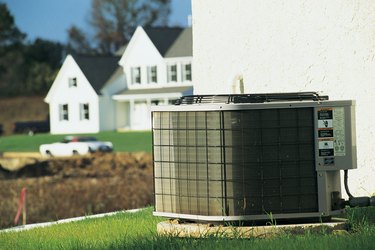 Home air conditioning uses almost 5 percent of all U.S.-produced electricity, according to the American Council for an Energy Efficient Economy. Image Credit: Comstock/Comstock/Getty Images
Home air conditioning uses almost 5 percent of all U.S.-produced electricity, according to the American Council for an Energy Efficient Economy. Image Credit: Comstock/Comstock/Getty Images
Your heating, ventilation and air-conditioning system, commonly referred to as HVAC, is designed to keep your home comfortable in all types of weather, but with the rising cost of energy that comfort comes at a price. You can lower your HVAC expenses by ensuring your unit is properly sized, based on its input BTUs and output BTUs.
Video of the Day
British Thermal Unit
The old rating system for describing the cooling power of a home air conditioner was referenced in tons of cooling. A ton was the equivalent of the cooling effect of 1 ton of ice melting over a 24-hour period. The more conventional method of rating both air conditioners and heating units is the British thermal unit, or BTU. One BTU refers to the amount of heat required to raise the temperature of 1 lb. pound of water by 1 degree Fahrenheit. 12,000 BTUs is considered the rough equivalent of 1 ton.
Input BTU
An HVAC unit's input BTU rating refers to the gross of amount of heating or cooling produced by your unit. Both heating and air conditioning units are traditionally rated by their input BTU capacity.
Output BTU
An HVAC unit's output BTU rating refers to the amount of usable heating or cooling your unit provides to your home. If your HVAC unit operates at 100 percent efficiency, the input BTU rating would be equal to its output BTU rating. The efficiency of an HVAC unit can be affected by several factors, including the age of the unit, the insulation of the home and the geographic location of the home and the unit.
Efficiency
The federal government rates air conditioning systems by their Seasonal Energy Efficiency Ratio, or SEER, typically ranging from 13 to 23, according to the California Energy Commission. Electric heat pump units are rated by their Heating Seasonal Performance Factor, or HSPF, typically ranging from 7.7 to 9.35. The higher the rating the more efficient the unit. To properly size your HVAC unit you need to compare its input BTU with its efficiency rating to determine the output BTUs, which is the usable heating and cooling capacity of your unit.







































